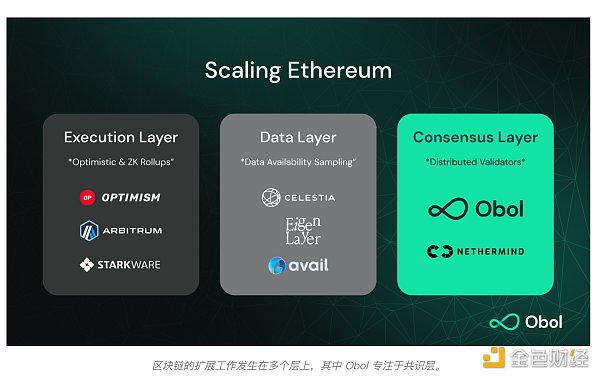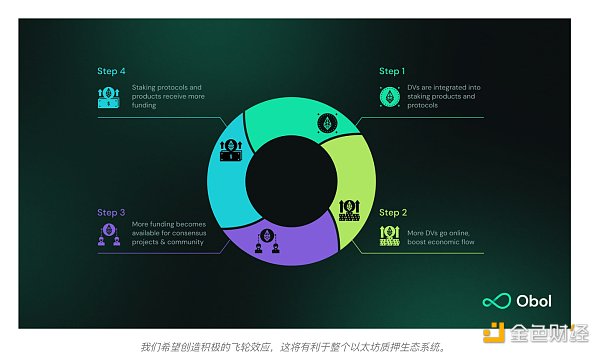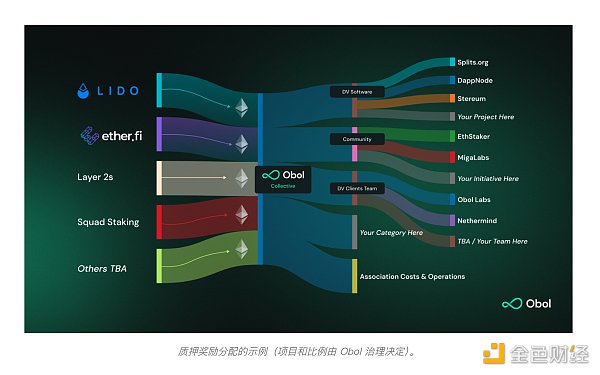Author: Obol Source: Obol official website Translation: Shan Ouba, Golden Finance
Abstract
Obol has launched a funding model to strengthen and promote the decentralization of Ethereum consensus. Users of the Obol Distributed Validator (DV) cluster will contribute 1% of their staking rewards to a retroactive funding pool. These funds will be used to reward projects and innovations that add value and have an impact on the decentralization of Ethereum.
1% for the Planet: 1% for Ethereum Consensus
In the early 2000s, Craig Mathews, founder of Patagonia, and Yvon Chouinard, founder of Blue Ribbon Files, created a Retroactive Public Goods Fund (RPGF) for the Earth, recognizing that companies that profit from the Earth's resources should also have a responsibility to protect the Earth. The resulting 1% for the Planet network quickly gained support from organizations around the world and ultimately certified more than $600 million in environmental donations.
For Ethereum projects, Ethereum consensus is like Mother Earth: it is the trusted foundation for all innovation happening today in our over $350 billion Ethereum ecosystem. The consensus layer is where the network reaches agreement on the current blockchain state through a consensus mechanism, which makes the security and decentralization of this layer critical. Just as businesses have a responsibility to protect the planet from which they harvest resources, now is the time for Ethereum staking projects to commit to strengthening Ethereum’s foundation - the consensus layer.
Making Ethereum Secure, Resilient, and Decentralized
A Precedent for Application Layer Funding
Current sources of backdoor funding primarily serve the application layer of the Ethereum network, focusing on “faster and cheaper” Layer 2 (L2) scaling solutions and new demand-driven applications that will scale the network to billions of users. The success of application layer funding has led to a burst of new projects and innovation in L2 as well as other applications such as liquid staking and re-staking. While these heroic efforts have paved the way for our mission, new projects at the application layer have made it more important than ever to secure and decentralize the consensus layer. The Ethereum network needs similar efforts and funding to scale the consensus layer.

Funding at the Consensus Layer
To achieve Ethereum’s mission, it needs secure, resilient, and decentralized consensus. That’s why we created Obol: to ensure that Ethereum consensus has the software and community it needs to remain credibly neutral and trust-minimized.
Today, we want to share the retroactive funding model we designed to strengthen and decentralize Ethereum consensus. As the Obol funding model grows, the Ethereum community will receive sustainable funding not only from the application layer, but also from the consensus layer of the network - the dawn of a new era.
Ecosystem Growth
Maintaining a distributed validator (DV) ecosystem requires more than just technology: it also requires a sustainable source of funding and a forward-looking allocation mechanism to drive innovation. As the ecosystem grows, network effects will drive more value and increase the flow of funds to Obol and the entire Ethereum ecosystem. This positive flywheel effect will accelerate a thriving ecosystem where teams and projects will work together to strengthen Ethereum's consensus layer.

History Lessons - Retroactive Funding of Ethereum
Proposals for Early Directed Block Rewards
In the early days of Ethereum, the community realized the lack of a mechanism to reward researchers and developers who developed and maintained the platform. In 2019, Kevin Owocki from Gitcoin, Greg Markou from Chainsafe, and Lane Rettig from the Ethereum Foundation proposed EIP-1890. Its purpose is to provide sustainable ecosystem funding by directing a portion of each block reward to a developer fund at the Ethereum protocol level. However, it turned out that directing funds from the L1 Ethereum protocol directly would call into question Ethereum’s neutrality, so the EIP was not implemented (the more recent EIP-2025 suffered a similar fate).
Directing L2 Collator Fees
While capturing and distributing rewards directly from the Ethereum protocol calls into question its credible neutrality, rewards generated from other layers of the Ethereum stack, such as Layer 2, do not. Optimism’s RetroPGF program, based on a design proposed by Vitalik in 2021, allocates a portion of revenue from Optimism’s Layer 2 collator. The program supports many young projects that are important to the Ethereum ecosystem: funding has been provided to over 250 projects to date, with the recent third round committing 30M OP tokens (over $100M). Optimism’s rival Arbitrum is also actively using their funds, and is currently in the third phase of the Arbitrum Foundation Grant Program. These retroactive funding programs have built a thriving ecosystem of projects, fueled innovation and delivered value to Layer 2 and the broader Ethereum scalability effort — it’s time to do the same for the Ethereum consensus layer.
1% for Decentralization
Funding via 1% Staking Rewards
Like 1% for the Planet, the 1% pledge idea exists in the Ethereum ecosystem: the Protocol Guild recently started a “1% Pledge” program, incentivizing projects to stake 1% of their native tokens for Ethereum protocol development. However, projects don’t need tokens to fund such a model: while Optimism now has their native OP token, initially they were using revenue from their L2 collators to power their public goods funding model. Why not do the same for validators?
A similar model could be replicated at the L1 consensus layer. Obol is launching this funding model to strengthen and promote the decentralization of Ethereum consensus: users of the Obol DV cluster will contribute 1% of their staking rewards to Obol, which will then be used to reward projects and innovations that add value and have an impact on the Ethereum consensus layer.
First Funding Contributors
The first contributor to participate in this model is Lido, through its SimpleDVT module that recently went live on mainnet - Lido is using Obol DV to onboard community operators and significantly expand its set of node operators. Soon, staking of EtherFi running on DV will provide an additional source of funding. (In fact, EtherFi was also the first project to commit to contributing 1% to the Protocol Guild.)
“Obol’s 1% Decentralization initiative is an excellent approach to strengthening the resilience and decentralization of the Ethereum protocol. The vision of a more accessible and resilient validator set can be ensured by improving the economic sustainability of DVT-related technology and research. Lido DAO contributors look forward to witnessing the further evolution of DVT adoption firsthand and supporting innovative teams contributing to this mission by running Obol validators on the Simple DVT module.” — Will Shannon, Lido Contributor, NOM Workflow
Allocating Funds to Decentralization-Oriented Projects
Obol aims to support anyone who adds value and impact to the decentralization of Ethereum’s consensus layer. This mission requires a community. We need technical partners, researchers, educators, ambassadors, community contributors, staking protocols, and of course, node operators to be part of the movement to strengthen Ethereum.
“At the Nethermind Research team, we see Obol’s 1% decentralization initiative as an important step towards the long-term security and resiliency of the Ethereum network. We are excited to see Sedge — our open-source Ethereum full node deployment tool — playing a role in this initiative by making it easier for developers to set up and manage validator nodes that use DVT.” — Michał Zając, Head of Research at Nethermind
We plan to launch an initial backported funding pilot round this year, focusing on projects that are providing value within the decentralized validator space. At this early stage, it is imperative to make DVs accessible to a wide range of users with different needs, implementations, and skill levels. One particularly impactful category of projects are decentralized validator “starters,” tools and products such as DappNode, Stereum, Sedge, and Splits.org that help users create and manage DVs. Other important efforts include education, research, testing, and community support, provided by projects such as EthStaker, Protocol Guild, MigaLabs, and DV Stakers.

These are just a few examples of impactful projects we have in mind - as we increase the number of distributed validators on mainnet and refine and improve our ability to run retroactive funding allocations, grant rounds will expand to cover large swaths of the ecosystem, improving decentralization on Ethereum.
This is just the beginning
Strengthening governance
This is just the beginning. There are a lot of details to figure out, and this model to refine and iterate on. In the coming months and years, Obol aims to become a more open, community-governed, and self-sustaining project. The goal is to provide support to individuals and projects for their contributions to strengthening Ethereum consensus, regardless of the type or size of their contribution.
To collect applications, vote, and allocate funds, we are experimenting with tools and building the required infrastructure. We will use the EasyRPG tool developed by the Gitcoin team, which itself is a public product developed after Optimism Round 3, and projects can use the tool to build their own retroactive funding rounds.
 JinseFinance
JinseFinance





